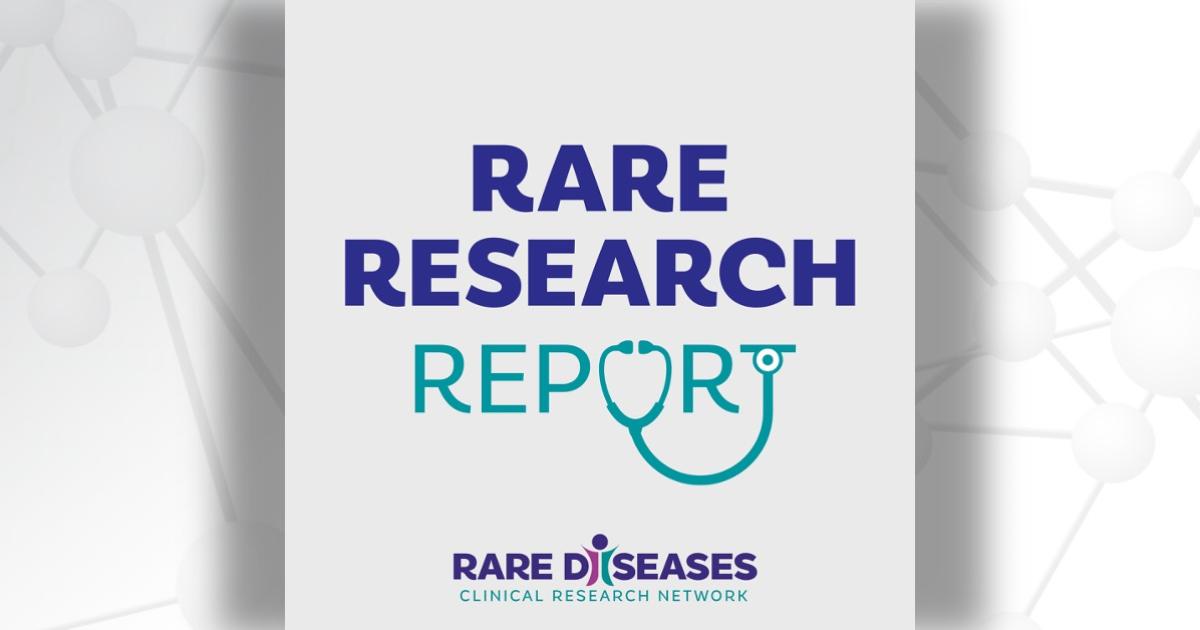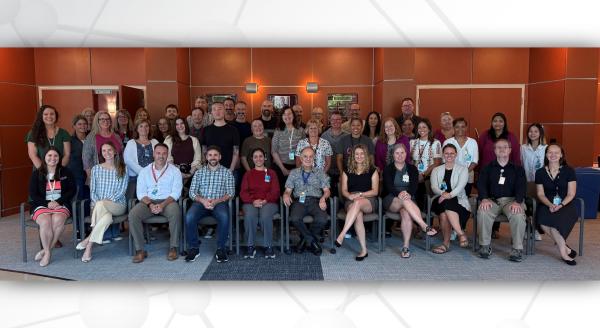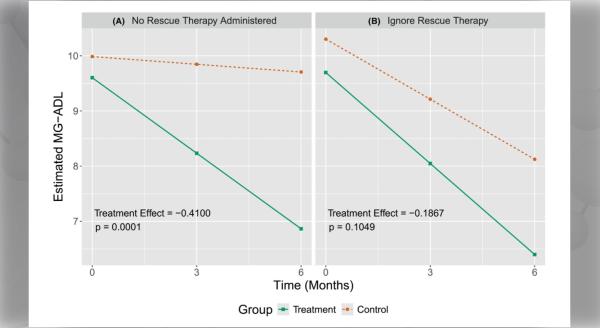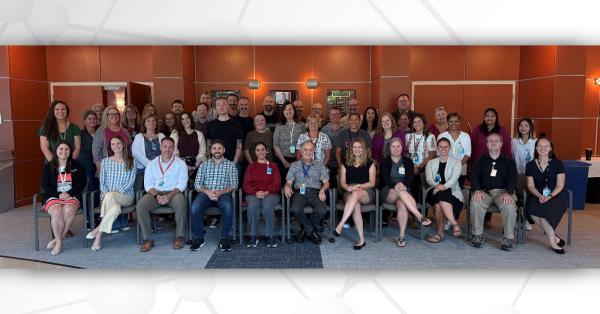Each month, we share summaries of recent Rare Diseases Clinical Research Network (RDCRN) grant-funded publications. Catch up on the latest RDCRN research below.
Jump to:
- Brain Vascular Malformation Consortium (BVMC)
- Clinical Research in ALS and Related Disorders for Therapeutic Development (CReATe) Consortium
- Developmental Synaptopathies Consortium (DSC)
- Genetic Disorders of Mucociliary Clearance Consortium (GDMCC)
- Primary Immune Deficiency Treatment Consortium (PIDTC)
Listen to these summaries on the Rare Research Report podcast.
Brain Vascular Malformation Consortium (BVMC)
Evaluating Enlarged Deep Medullary Veins in Patients with Sturge-Weber Syndrome
Sturge-Weber syndrome (SWS) is a condition resulting in abnormal blood vessel development in the brain, eyes, and skin at birth. In patients with SWS, enlarged deep medullary veins (EDMVs)—located in the white matter in the brain—could allow for drainage of brain regions affected by leptomeningeal venous malformations (LVM), a type of vascular malformation of the brain.
In this study, researchers evaluated the prevalence, extent, hemispheric differences, and clinical correlates of EDMVs in SWS. Fifty children with SWS underwent brain magnetic resonance imaging that included susceptibility weighted imaging, as well as neurocognitive evaluations. The team then assessed the extent of EDMVs, comparing between patients with right and left hemispheric SWS.
Results show that EDMVs are common in SWS. For patients with right hemispheric SWS, extensive EDMVs appear to develop more commonly and earlier than in left hemispheric SWS. Authors note that deep venous remodeling may contribute to better clinical outcomes in some patients with SWS.
Juhász C, Luat AF, Behen ME, Gjolaj N, Jeong JW, Chugani HT, Kumar A. Deep Venous Remodeling in Unilateral Sturge-Weber Syndrome: Robust Hemispheric Differences and Clinical Correlates. Pediatr Neurol. 2023 Feb;139:49-58. doi: 10.1016/j.pediatrneurol.2022.11.011. Epub 2022 Nov 25. PMID: 36521316; PMCID: PMC9840672.
Clinical Research in ALS and Related Disorders for Therapeutic Development (CReATe) Consortium
Primary progressive multiple sclerosis (PPMS) and hereditary spastic paraplegia (HSP) are inherited disorders affecting nerves that send messages to the muscles. Because patients with both disorders can present with slowly progressive spastic paraparesis (weakness in the legs), accurate diagnoses are often challenging.
In this study, researchers investigated the use of serum neurofilament light chain (sNfL) and glial fibrillary acidic protein (sGFAP) as biomarkers to support diagnosis. The team assessed sNfl and sGFAP levels in 25 patients with PPMS, 25 patients with spastic paraplegia type 4 (SPG4, the most common type of HSP), and 60 control subjects.
Results showed that sNfl levels were significantly higher in patients with PPMS compared to patients with SPG4. Researchers also observed a trend toward relatively higher sGFAP levels in patients with PPMS. However, because both groups of patients showed overlapping biomarker values, the team did not find sNfL and sGFAP to be useful biomarkers. As findings indicate that sNfL and sGFAP are most significantly elevated in the early disease stages of PPMS, authors note that further investigation is warranted.
Kessler C, Ruschil C, Abdelhak A, Wilke C, Maleska A, Kuhle J, Krumbholz M, Kowarik MC, Schüle R. Serum Neurofilament Light Chain and Glial Fibrillary Acidic Protein as Biomarkers in Primary Progressive Multiple Sclerosis and Hereditary Spastic Paraplegia Type 4. Int J Mol Sci. 2022 Nov 3;23(21):13466. doi: 10.3390/ijms232113466. PMID: 36362248; PMCID: PMC9657281.
Developmental Synaptopathies Consortium (DSC)
PTEN hamartoma tumor syndrome (PHTS) is a spectrum of disorders caused by mutations in the PTEN gene, which typically suppresses formation of tumors. In addition to its role in cancer, PTEN plays crucial roles in brain function. Individuals with PHTS show distinct neurobehavioral profiles, suggesting primary disruption of frontal lobe systems. More severe cognitive deficits are seen in individuals with associated autism spectrum disorder (ASD) that also extend to other areas of neurobehavioral function, such as adaptive behavior and sensory deficits.
In this study, researchers aimed to characterize longitudinal neurobehavioral profiles in individuals with PHTS. Ninety-two children and young adults with PHTS and/or ASD completed two to three neurobehavioral evaluations over a two-year time period. The team used spaghetti plots and linear mixed effects models to visualize individual patient profiles and group trends, examining differences in cognitive and behavioral test scores over time.
Results suggest that neurobehavioral characteristics observed in individuals with PHTS remain relatively stable over time, even in those with ASD. Reliable change indices and standardized regression-based change scores were calculated and provided in an easy-to-use Excel calculator that can be used in future research to examine patient outcomes at the individual level and inform intervention strategies.
Busch RM, Frazier Ii TW, Sonneborn C, Hogue O, Klaas P, Srivastava S, Hardan AY, Martinez-Agosto JA, Sahin M, Eng C. Longitudinal neurobehavioral profiles in children and young adults with PTEN hamartoma tumor syndrome and reliable methods for assessing neurobehavioral change. J Neurodev Disord. 2023 Jan 14;15(1):3. doi: 10.1186/s11689-022-09468-4. PMID: 36641436; PMCID: PMC9840250.
Genetic Disorders of Mucociliary Clearance Consortium (GDMCC)
Investigating the Role of Airway Inflammation in Children with Primary Ciliary Dyskinesia
Primary ciliary dyskinesia (PCD) is an inherited condition in which mucociliary clearance of the lungs is impaired. In this disorder, cilia (hairlike structures) lining the airway, sinuses, and middle ears have defective movements, leading to accumulation of harmful particles and pathogens trapped within mucus. Currently, not much is known about the role of airway inflammation in the development of PCD in children.
In this study, researchers investigated the relationships between sputum (mucus) inflammation measurements, age, lung function, bronchiectasis, airway infection, and ultrastructural defects in children with PCD. The team collected spontaneously expectorated sputum from clinically stable children and adolescents with PCD ages six years and older. Next, the team correlated sputum protease and inflammatory cytokine concentrations with age, lung function, and chest computed tomography measures of structural lung disease.
Results show that in this multicenter cohort of pediatric patients with PCD, elevated concentrations of sputum proteases and cytokines were associated with impaired lung function and structural damage as determined by chest computed tomography. These results establish an important linkage between airway inflammation and lung disease in PCD. Authors note that these findings also suggest sputum inflammatory measurements could serve as biomarkers in PCD and could be used to assess the efficacy of anti-inflammatory therapies.
Sagel SD, Kupfer O, Wagner BD, Davis SD, Dell SD, Ferkol TW, Hoppe JE, Rosenfeld M, Sullivan KM, Tiddens HAWM, Knowles MR, Leigh MW. Airway Inflammation in Children with Primary Ciliary Dyskinesia. Ann Am Thorac Soc. 2023 Jan;20(1):67-74. doi: 10.1513/AnnalsATS.202204-314OC. PMID: 35984413; PMCID: PMC9819265.
Primary Immune Deficiency Treatment Consortium (PIDTC)
Artemis-deficient severe combined immunodeficiency (ART-SCID) is a rare form of primary immune deficiency caused by mutations in the DCLRE1C gene. Allogeneic hematopoietic-cell transplantation, the standard treatment for patients with SCID, can effectively treat other forms of SCID. However, ART-SCID does not respond well to this therapy, highlighting the need for alternative treatments.
In this study, researchers evaluated the effects of transfusing lentiviral gene-corrected autologous CD34+ bone marrow cells in 10 infants with newly diagnosed ART-SCID. The team followed these patients for a median of 31.2 months.
Findings showed that infusion of these bone marrow cells—after conditioning with a low dose of the chemotherapy drug busulfan—resulted in genetically corrected and functional T and B cells. Authors state that larger studies of longer duration are needed to further assess the safety and efficacy of this approach.
Cowan MJ, Yu J, Facchino J, Fraser-Browne C, Sanford U, Kawahara M, Dara J, Long-Boyle J, Oh J, Chan W, Chag S, Broderick L, Chellapandian D, Decaluwe H, Golski C, Hu D, Kuo CY, Miller HK, Petrovic A, Currier R, Hilton JF, Punwani D, Dvorak CC, Malech HL, McIvor RS, Puck JM. Lentiviral Gene Therapy for Artemis-Deficient SCID. N Engl J Med. 2022 Dec 22;387(25):2344-2355. doi: 10.1056/NEJMoa2206575. PMID: 36546626.
The Rare Diseases Clinical Research Network (RDCRN) is funded by the National Institutes of Health (NIH) and led by the National Center for Advancing Translational Sciences (NCATS) through its Division of Rare Diseases Research Innovation (DRDRI). Now in its fourth five-year funding cycle, RDCRN is a partnership with funding and programmatic support provided by Institutes, Centers, and Offices across NIH, including the National Institute of Neurological Disorders and Stroke, the National Institute of Allergy and Infectious Diseases, the National Institute of Diabetes and Digestive and Kidney Diseases, the Eunice Kennedy Shriver National Institute of Child Health and Human Development, the National Institute of Arthritis and Musculoskeletal and Skin Diseases, the National Heart, Lung, and Blood Institute, the National Institute of Dental and Craniofacial Research, the National Institute of Mental Health, and the Office of Dietary Supplements.






